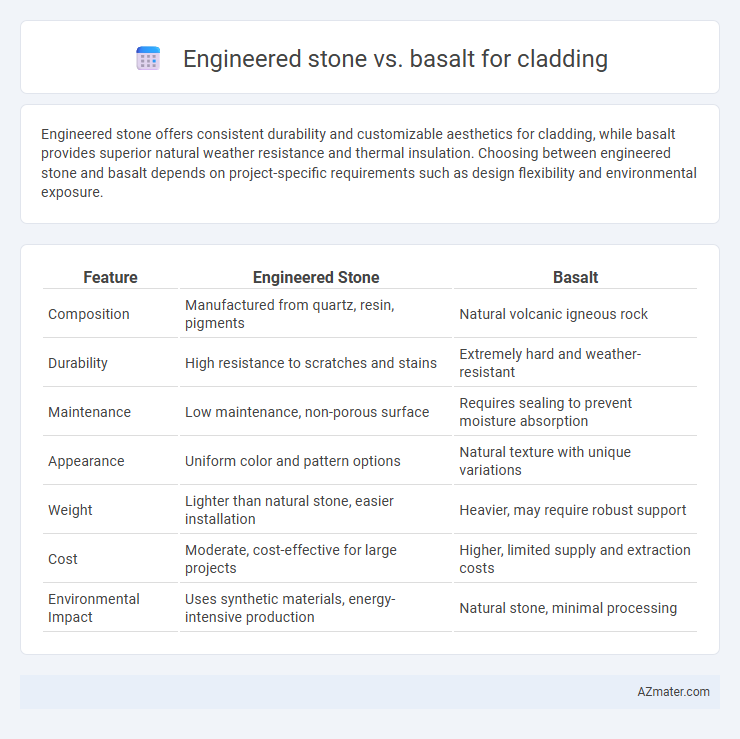Engineered stone offers consistent durability and customizable aesthetics for cladding, while basalt provides superior natural weather resistance and thermal insulation. Choosing between engineered stone and basalt depends on project-specific requirements such as design flexibility and environmental exposure.
Table of Comparison
| Feature | Engineered Stone | Basalt |
|---|---|---|
| Composition | Manufactured from quartz, resin, pigments | Natural volcanic igneous rock |
| Durability | High resistance to scratches and stains | Extremely hard and weather-resistant |
| Maintenance | Low maintenance, non-porous surface | Requires sealing to prevent moisture absorption |
| Appearance | Uniform color and pattern options | Natural texture with unique variations |
| Weight | Lighter than natural stone, easier installation | Heavier, may require robust support |
| Cost | Moderate, cost-effective for large projects | Higher, limited supply and extraction costs |
| Environmental Impact | Uses synthetic materials, energy-intensive production | Natural stone, minimal processing |
Introduction to Cladding Materials
Engineered stone and basalt are prominent cladding materials known for their durability and aesthetic appeal in architectural applications. Engineered stone combines natural quartz with resin to offer a versatile, lightweight option resistant to staining and weathering. Basalt, a natural volcanic rock, provides exceptional strength, thermal resistance, and a unique textured surface ideal for high-performance exterior facades.
What is Engineered Stone?
Engineered stone, composed primarily of crushed natural quartz combined with resin and pigments, offers enhanced durability and a wide range of colors for cladding applications. Unlike basalt, a natural volcanic rock known for its hardness and thermal resistance, engineered stone provides consistent patterns and easier maintenance. These properties make engineered stone a popular choice in modern architectural cladding for both aesthetic appeal and long-lasting performance.
Understanding Basalt as a Cladding Option
Basalt, a natural volcanic rock, offers exceptional durability and weather resistance as a cladding material, making it ideal for exterior facades exposed to harsh conditions. Engineered stone, while versatile and customizable in color and texture, often lacks basalt's inherent strength and natural thermal insulation properties. Understanding basalt's ecological sustainability and low maintenance requirements highlights its growing preference over engineered stone in modern architectural cladding projects.
Aesthetic Comparison: Engineered Stone vs Basalt
Engineered stone offers a wide range of customizable colors and patterns, creating consistent and uniform aesthetics ideal for modern architectural cladding. Basalt, on the other hand, provides a natural, textured appearance with unique veining and earthy tones that enhance the organic look of building exteriors. The choice between engineered stone and basalt for cladding depends on desired visual effects, with engineered stone emphasizing uniformity and versatility, while basalt highlights natural beauty and rustic appeal.
Durability and Strength: Side-by-Side Analysis
Engineered stone offers exceptional durability and consistent strength due to its composite materials, making it resistant to scratches, stains, and impact, ideal for high-traffic cladding applications. Basalt, a natural volcanic rock, excels in compressive strength and weather resistance, providing superior longevity and minimal maintenance under harsh environmental conditions. Both materials deliver robust performance, but basalt's inherent density and natural hardness often surpass engineered stone in structural resilience for exterior cladding.
Weather and Stain Resistance: Which Performs Better?
Engineered stone exhibits superior stain resistance due to its non-porous surface, making it less susceptible to staining from environmental pollutants and spills, while basalt offers exceptional weather resistance because of its natural volcanic origin and dense mineral composition, allowing it to withstand extreme temperature fluctuations and UV exposure without significant degradation. Basalt's inherent durability provides long-term resilience in harsh outdoor conditions, whereas engineered stone may require periodic sealing to maintain its stain-resistant properties. When prioritizing weather resistance in cladding, basalt performs better, but for stain resistance, engineered stone holds the advantage.
Installation Process and Costs
Engineered stone cladding offers a uniform surface with faster installation due to its lightweight panels and simpler cutting requirements, reducing labor costs significantly. Basalt cladding requires skilled workmanship for precise handling of heavy, natural stone slabs, contributing to higher installation expenses and longer project timelines. While engineered stone typically costs 20-30% less upfront, basalt's durability may offer long-term value despite the initial increased installation investment.
Sustainability and Environmental Impact
Engineered stone cladding often involves synthetic resins and requires significant energy for production, posing challenges for sustainability compared to natural basalt, which is a volcanic rock with minimal processing and longer durability. Basalt's extraction and installation generally have a lower carbon footprint and it is fully recyclable, making it an environmentally superior option for green building projects. However, engineered stone's use of recycled materials and controlled waste management can mitigate some environmental impacts in specific applications.
Maintenance Requirements and Lifespan
Engineered stone cladding requires minimal maintenance, with periodic cleaning to prevent surface staining and occasional resealing to maintain durability, offering a lifespan of 20 to 30 years under normal conditions. Basalt cladding is highly durable and naturally resistant to weathering, requiring very little maintenance beyond routine washing to remove dirt and debris, and can last over 50 years due to its inherent strength and low porosity. The choice between engineered stone and basalt hinges on balancing maintenance frequency and longevity, with basalt providing superior lifespan and lower upkeep in demanding environments.
Choosing the Right Cladding: Key Considerations
Engineered stone offers customizable patterns, high durability, and consistent color, making it ideal for modern architectural cladding with uniform aesthetics. Basalt provides natural thermal resistance, exceptional strength, and unique texture, enhancing the facade's environmental performance and authenticity. Key considerations include project budget, desired visual impact, maintenance requirements, and weather exposure to determine which material aligns best with the building's functional and design goals.

Infographic: Engineered stone vs Basalt for Cladding
 azmater.com
azmater.com